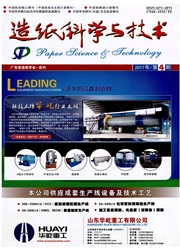

 中文摘要:
中文摘要:
硫酸盐法蒸煮过程中植物纤维原料所含有的甲氧基与氢氧化钠发生反应而产生甲醇。本文研究了竹子硫酸盐法蒸煮过程中甲醇产生历程与甲氧基脱除历程的关系,以及蒸煮用碱量、硫化度和保温时间等工艺参数变化时,甲醇发生量与甲氧基脱除率的变化规律。结果表明,甲醇产生历程与甲氧基脱除历程是不同的。甲醇产生历程分为两个阶段:第一阶段甲醇慢速产生阶段,从蒸煮开始升温到105℃,甲醇产生量为0.40 kg/t(odp);第二阶段甲醇快速产生阶段,从105℃到最高温度165℃下保温阶段,甲醇产生量由0.40增大到3.07 kg/t(odp)。甲氧基脱除历程分为两个阶段:第一阶段甲氧基快速脱除阶段,从蒸煮开始到升温至蒸煮最高温度;第二阶段为甲氧基慢速脱除阶段,最高温度(165℃)下保温阶段。增加用碱量、延长保温时间会增大甲醇发生量以及甲氧基脱除率。
 英文摘要:
英文摘要:
Methanol is formed during the alkaline pulping by the demethoxylation of methoxyl groups found mainly on the lignin and hemicellulose existing in plant fiber material. The relationship between methanol formation process and demethoxyl process during the kraft cooking of bamboo, and the regularity of methanol generation and methoxy group removal as the parameters (alkali charge, sulfidity and holding time at maximum temperature) varied , were studied. The results showed that both methanol generation process and methoxyl removal process could be divided into two stages , but there was significant difference between methanol formation and methoxyl removal. The metha- nol formation proceeded in two distinct phase: slow methanol formation ( from the beginning of the cooking to 105℃ ,the amount of methanol formed was 0.40 kg/t(odp) ) and rapid methanol formation (from 105℃ to the end of the cooking, the amount of methanol increased from 0.40 to 3.07 kg/t (odp) ). The methoxyl removal process could be divided into fast demethoxylation phase (from the beginning of the cooking to the maximum temperature 165℃ ) and slow demethoxylation phase (period of cooking at Y 165℃ ). As the alkali charge increased and the holding time at Tmax extended, both the methanol generation and the methoxyl removal rate would increase.
 同期刊论文项目
同期刊论文项目
 同项目期刊论文
同项目期刊论文
 期刊信息
期刊信息
